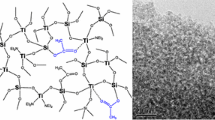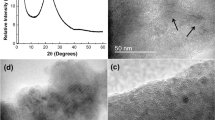Abstract
Novel non-hydrolytic syntheses of titanosilicate xerogels by polycondensation of silicon acetate, Si(OAc)4, with titanium (IV) dimethylamide or diethylamide, Ti(NR2)4 (R = Me, Et), are presented. The reactions are based on acetamide elimination and yield gels with a high content of Si–O−Ti bonds in comparison with the ester elimination route. Although a ligand exchange was observed, it was interestingly not followed by homo-condensation and during the synthesis the phase separation to SiO2 and TiO2 was avoided. The degree of condensation reached up to 68 %. The xerogels prepared for a comparison by ester elimination from Si(OAc)4 and titanium (IV) isopropoxide featured a significantly lower content of the Si–O–Ti bonds. The initial tests in the epoxidation of cyclohexene by cumyl hydroperoxide (CHP) indicated a high selectivity and moderate activity of the xerogels. The catalytic properties were significantly improved by combining non-hydrolytic and hydrolytic methods yielding mesoporous and homogeneous Si/Ti mixed oxides. The catalysts prepared by these methods provided a complete epoxidation of cyclohexene in 2 h at 65 °C.







Similar content being viewed by others
References
Debecker DP, Mutin PH (2012) Non-hydrolytic sol–gel routes to heterogeneous catalysts. Chem Soc Rev 41:3624–3650
Vioux A (1997) Nonhydrolytic sol-gel routes to oxides. Chem Mater 9(11):2292–2299
Hay JN, Raval HM (2001) Synthesis of organic-inorganic hybrids via the non-hydrolytic sol-gel process. Chem Mater 13(10):3396–3403
Clavel G, Rauwel E, Willinger M-G, Pinna N (2009) Non-aqueous sol-gel routes applied to atomic layer deposition of oxides. J Mater Chem 19:454–462
Mutin PH, Vioux A (2009) Nonhydrolytic processing of oxide-based materials: simple routes to control homogeneity, morphology, and nanostructure. Chem Mater 21(4):582–596
Niederberger M (2007) Nonaqueous sol-gel routes to metal oxide nanoparticles. Acc Chem Res 40(9):793–800
Davis RJ, Liu Z (1997) Titania-silica: a model binary oxide catalyst system. Chem Mater 9(11):2311–2324
Fujiwara M, Wessel H, Hyung-Suh P, Roesky HW (2002) Formation of titanium tert-butylperoxo intermediate from cubic silicon-titanium complex with tert-butyl hydroperoxide and its reactivity for olefin epoxidation. Tetrahedron 58(2):239–243
Dusi M, Mallat T, Baiker A (2000) Epoxidation of functionalized olefins over solid catalysts. Catal Rev Sci Eng 42(1–2):213–278
Lorret O, Lafond V, Mutin PH, Vioux A (2006) One-step synthesis of mesoporous hybrid titania-silica xerogels for the epoxidation of alkenes. Chem Mater 18(20):4707–4709
Müller CA, Deck R, Mallat T, Baiker A (2000) Hydrophobic titania-silica aerogels: epoxidation of cyclic compounds. Top Catal 11(1–4):369–378
Notari B, Willey RJ, Panizza M, Busca G (2006) Which sites are the active sites in TiO2-SiO2 mixed oxides? Catal Today 116(2):99–110
Lafond V, Mutin PH, Vioux A (2002) Non-hydrolytic sol-gel routes based on alkylhalide elimination: toward better mixed oxide catalyst and new supports application to the preparation of a SiO2-TiO2 epoxidation catalyst. J Mol Catal A: Chem 182–183:81–88
Lafond V, Mutin PH, Vioux A (2004) Control of the texture of titania-silica mixed oxides prepared by nonhydrolytic sol-gel. Chem Mater 16(25):5380–5386
Andrianainarivelo M, Corriu R, Leclerq D, Mutin PH, Vioux A (1996) Mixed oxides SiO2-ZrO2 and SiO2-TiO2 by a non-hydrolytic sol-gel route. J Mater Chem 6(10):1665–1671
Cojocariu AM, Mutin PH, Dumitriu E, Fajula F, Vioux A, Hulea V (2010) Mild oxidation of bulky organic compounds with hydrogen peroxide over mesoporous TiO2-SiO2 xerogels prepared by non-hydrolytic sol-gel. Appl Catal B 97:407–413
Cojocariu AM, Mutin PH, Dumitriu E, Aboulaich A, Vioux A, Fajula F, Hulea V (2010) Non-hydrolytic SiO2-TiO2 mesoporous xerogels-efficient catalysts for the mild oxidation of sulfur organic compounds with hydrogen peroxide. Catal Today 157:270–274
Henderson GS, Fleet ME (1997) The structure of titanium silicate glasses investigated by Si K-edge X-ray absorption spectroscopy. J Non-Cryst Solids 211(3):214–221
Goubeau J, Mundiel RZ (1953) Uber das trichlorsiliciumacetat. Z Anorg Allg Chem 272(1–4):313–326
Gueba-Neyroud T, Tumanskii B, Botoshansky M, Eisen MS (2007) Synthesis, characterization and catalytic activity of the complex titanium bis(dimethylmalonate)-bis(diethylamido) in the polymerization of propylene. J Organomet Chem 692(5):927–939
Iwasaki M, Yasumori A, Shibata S, Yamane M (1994) Preparation of high homogeneity BaO-TiO2-SiO2 gel. J Sol-Gel Sci Technol 2:387–391
Jansen M, Guenther E (1995) Oxide gels and ceramics prepared by a nonhydrolytic sol-gel process. Chem Mater 7(11):2110–2114
Coltrain BK, Kelts LV, Armstrong NJ, Salva JM (1994) Silicon tetraacetate as a sol-gel precursor. J Sol-Gel Sci Technol 3:83–90
Innocenzi P (2003) Infrared spectroscopy of sol-gel derived silica-based films: a spectra-microstructure overview. J Non-Cryst Sol 316(2–3):309–319
Deacon GB, Phillips RJ (1980) Relationship between the carbon-oxygen stretching frequencies of carboxylato complexes and the type of carboxylate coordination. Coord Chem Rev 33(3):227–250
Alcock NW, Tracy VM, Waddington TC (1976) Acetates and acetato-complexes. 2. Spectroscopic studies. J Chem Soc Dalton 21:2243–2246
Rotzinger FP, Kesselman-Truttmann JM, Hug SJ, Shklover V, Graetzel M (2004) Structure and vibrational spectrum of formate and acetate adsorbed from aqueous solution onto the TiO2 rutile (110) surface. J Phys Chem B 108(16):5004–5017
Dutoit DCM, Schneider M, Baiker A (1995) Titania-silica mixed oxides. 1. Influence of sol-gel and drying conditions on structural properties. J Catal 153(1):165–176
Smith DY, Black CE, Homes CC, Shiles E (2007) Optical properties of TiO2-SiO2 glass over a wide spectral range. Phys Stat Sol 4(3):838–842
Frot T, Cochet S, Laurent G, Sassoye C, Popall M, Sanchez C, Rozes L (2010) Ti8O8(OOCR)16, a new family of titanium–oxo clusters: potential NBUs for reticular chemistry. Eur J Inorg Chem 36:5650–5659
Birnie DP III, Bendzko NJ (1999) 1H and 13C NMR observation of the reaction of acetic acid with titanium isopropoxide. Mater Chem Phys 59:26–35
Balmer ML, Bunker BC, Wang LQ, Peden CHF, Su Y (1997) Solid-state 29Si MAS NMR study of titanosilicates. J Phys Chem B 101(45):9170–9179
Labouriau A, Higley TJ, Earl WL (1998) Chemical shift prediction in the 29Si MAS NMR of titanosilicates. J Phys Chem B 102(16):2897–2904
Zibrowius B, Weidenthaler C, Schmidt W (2003) Sorbate-induced changes in the framework of the titanosilicate ETS-10 as detected by 29Si MAS NMR spectroscopy and X-ray powder diffraction. Phys Chem Chem Phys 5(4):773–777
Eimer GA, Casuscelli SG, Ghione GE, Crivello ME, Herrero ER (2006) Synthesis, characterization and selective oxidation properties of Ti-containing mesoporous catalysts. Appl Catal A General 298:32–242
Liu Z, Davis RJ (1994) Investigation of the structure of microporous Ti-Si mixed oxides by X-ray, UV reflectance, FT-Raman, and FT-IR spectroscopies. J Phys Chem 98:1253–1261
Murugavel R, Davis P, Shete VS (2003) Reactivity studies, structural characterization, and thermolysis of cubic titanosiloxanes: precursors to titanosilicate materials which catalyze olefin epoxidation. Inorg Chem 42(15):4696–4706
Mathur S, Veith M, Shen H, Hüfner S, Jilavi MH (2002) Structural and optical properties of NdAlO3 nanocrystals embedded in an Al2O3 matrix. Chem Mater 14(2):568–582
Coles MP, Lugmair CG, Terry KW, Tilley TD (2000) Titania-silica materials from the molecular precursor Ti[OSi(OtBu)3]4: selective epoxidation catalysts. Chem Mater 12(1):122–131
Hutter R, Mallat T, Baiker A (1995) Titania-silica mixed oxides. 2. Catalytic behavior in olefin epoxidation. J Catal 153(1):177–189
Acknowledgments
Authors thank the University of Cologne and the project CEITEC—Central European Institute of Technology (CZ.1.05/1.1.00/02.0068) for the financial assistance. The ERASMUS program is acknowledged for enabling the stay of A. S. in Cologne. Authors thank Dr. Z. Moravec for measuring N2 adsorption–desorption isotherms, L. Xiao, Dr. S. Stucky, Dr. V. Vavra, and Dr. P. Bezdicka for recording the XRD data, O. Arslan and Dr. Z. Moravec for measuring thermal analysis, and J. Abbott for assistance with the solid state NMR experiments. The helpful discussions with Dr. W. Tyrra, Dr. A. P. Singh and Dr. S. Stucky are gratefully acknowledged.
Author information
Authors and Affiliations
Corresponding authors
Rights and permissions
About this article
Cite this article
Styskalik, A., Skoda, D., Pinkas, J. et al. Non-hydrolytic synthesis of titanosilicate xerogels by acetamide elimination and their use as epoxidation catalysts. J Sol-Gel Sci Technol 63, 463–472 (2012). https://doi.org/10.1007/s10971-012-2808-5
Received:
Accepted:
Published:
Issue Date:
DOI: https://doi.org/10.1007/s10971-012-2808-5




